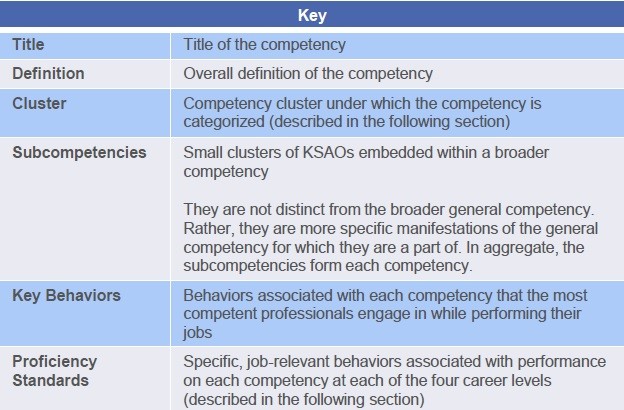The Competency Model

One of the primary benefits of the SHRM Competency Model is that HR professionals can use it to guide their career development. SHRM developed the model to apply across the entire HR career lifecycle and is continually producing new activities, tools, and other content to help individuals in their current career level as well as to prepare for the next career level.
There are several ways you can assess your proficiency in these competencies. First and foremost, if you are not already certified, or if your certification has lapsed, you can sign up to become certified. In preparation for certification, you can purchase access to the SHRM e-Learning System where you will have the opportunity to take a practice assessment (in addition to learning more about what knowledge and behaviors are critical to successful HR performance).
In addition, SHRM offers a suite of Competency Diagnostic Tools that can be used by individuals and organizations to assess their proficiency level at various career stages for each competency. These assessments include:
- Self-Tool–assess how proficient you see yourself in each competency
- 180 Tool–capture your own perceived proficiency in each competency as well as your supervisor’s perception of your proficiency
- 360 Tool–allow your direct reports or others, along with you and your supervisor, to assess your proficiency in each competency
Through each of these tools, you can get a robust sense of your proficiency in the competencies necessary for success as an HR professional.
SHRM’s Competency Model for HR professionals consists of nine competencies:
- Human Resource Expertise (HR Knowledge)
- Ethical Practice
- Leadership and Navigation
- Business Acumen
- Consultation
- Critical Evaluation
- Communication
- Global and Cultural Effectiveness
- Relationship Management
Developing a robust, tiered competency model for the HR profession has allowed SHRM to identify how best to serve members at each stage of their careers. Where possible, SHRM aligns its products, conference sessions, publications and other resources to the SHRM Competency Model. In this report, we describe the SHRM Competency Model and its competencies in detail.

Model Key
Each competency consists of six distinct elements: title, definition, cluster, subcompetencies, key behaviors and proficiency standards.These elements are discussed in the key below.

HR Professional Career Levels
Early Level
•An “Early Level” HR professional is characterized in the following way:
•Little to no experience
•Supports operational functions
•May manage small-sized projects
•Carries out the HR plan at the transactional level
Mid Level
•A “Mid Level” HR professional is characterized in the following way:
•Moderate experience
•Leads or supports operational functions
•Leads or manages small-to mid-sized projects
•Implements the HR plan and contributes to its refinement
Senior Level
•A “Senior Level” HR professional is characterized in the following way:
•Significant experience
•Serves as a high-level strategic and/or operational leader or as an experienced HR consultant
•Oversees large or multiple programs or projects
•Operationalizes HR strategy and translates strategy into a plan
Executive Level
•An “Executive Level” HR professional is characterized in the following way:
•Typically is one of the most senior leaders in HR
•Holds the top HR job in the organization or VP role
HR Professional Competency Clusters
HR professionals are business leaders who, whether formally or informally, must frequently take on leadership roles regardless of their level within the organization. SHRM research indicates that effectiveness as an HR leader is a function of technical (T) knowledge of HR plus three behavioral clusters –leadership (L), business (B) and interpersonal (I). SHRM refers to this model as the LBIT Model.
The initial component of the model is HR technical expertise. Together, the technical areas represent the collective HR Expertise (HR Knowledge) needed to succeed as an HR professional. Examples of these technical areas include employee and labor relations, compensation and benefits, talent acquisition, and learning and development.
The second cluster of competencies is interpersonal proficiency. A key factor for achieving success is the proficiency demonstrated in managing relationships, communicating information, and demonstrating deft global and cultural sensitivities. In addition, a significant part of an HR professional’s job is characterized by interdependence with stakeholders. Accordingly, this cluster consists of the Communication, Relationship Managementand Global and Cultural Effectiveness competencies.
The third cluster of competencies is business-oriented proficiency. A key factor for achieving success is proficiency in analyzing and interpreting data, offering coaching and consultative services, and making savvy business decisions for the organization. Further, today’s HR professionals are considered business partners across the organization. Thus, they must be able to (a) understand and apply information to contribute to the organization’s strategic plan, (b) interpret information to make business decisions and recommendations, and (c) provide guidance to organizational stakeholders. In other words, these successful practitioners are proficient in the competencies that make up this cluster: Business Acumen, Critical Evaluationand Consultation.
The final cluster of competencies is leadership proficiency. A key factor for achieving success is the proficiency demonstrated in navigating the landscape of industry, engendering cooperation, driving results with strategic planning and execution, and practicing ethically for corporate social responsibility. This cluster consists of the Leadership and Navigation and Ethical Practice competencies.
you can continue studying this content via below link:
جهت ارسال نظر وارد سایت شوید




